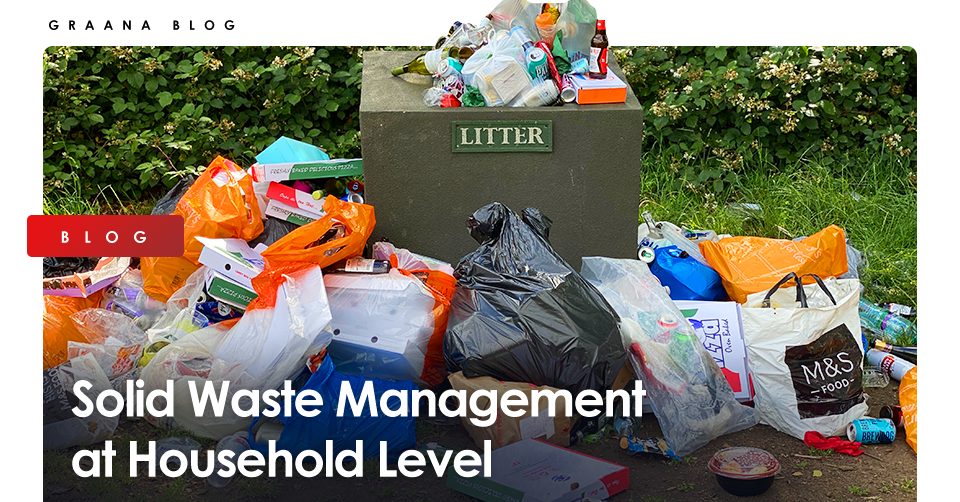As the cities across the globe are expanding, so is the consumption of resources is reaching an unprecedented level. Developed and developing countries alike face a dilemma that consumption of goods at the micro and macro level is increasing while managing this solid waste is becoming difficult. What we consume eventually becomes a part of our garbage cans, and if managed improperly eventually starts to occupy the space of our environment. It is reported by the International Union for Conservation of Nature (IUCN) that almost 8 million tons of plastic become a part of oceans every year and the situation can aggravate if necessary measures are not timely devised.
Inclusive development is only possible if every aspect of development is addressed therefore, policies are designed such that unforeseen scenarios and minimal aspects of a problem can be addressed timely. Moreover, at a time when every aspect of development is scanned through sustainable development, solid waste management emerges as a core issue that needs an appropriate redressal. In a study conducted in the Philippines, it was estimated that households generate 3.2kg of waste per day and if we keep on moving up on the ladder the waste disposed of by industries, municipalities and agriculture will be way much more.
Graana.com highlights the importance of household waste management and how managing waste at the household level have a positive impact on the overall environment.
Household Waste Management
The term ‘Household Waste Management’ refers to the collection, treatment, and disposal of waste at the household level. Solid waste from households is one of the major contributors to municipal waste. It is estimated by the World Bank that our planet generates 2.01bn of municipal waste per annum. Waste management has a great value attached to the conservation of resources, prevention of nature, and reduction of pollution however, the subject is unable to convert most of the waste into a useful resource due to lack of seriousness, resources, and innovation.
One thing that is pertinent to mention here is that waste management is not only about reducing the size or incinerating the product rather it is also about managing the waste in a way that has no hazardous impact on the environment and conversion of waste into a useful product i.e. fuel, biomass, or a recycled product. Furthermore, it is being estimated that solid waste will reach 3.02bn tonnes by 2050.
‘Waste-to-Value’ is a concept in waste management that is about converting solid waste into a useful resource. Thus various techniques are employed to convert waste into fuel or recycled materials that help to reduce the burden on our environment. Some of the important techniques include dry waste recycling, and wet waste composting. Similarly, the usefulness of the waste-to-value can be gauged from the fact that green gas houses are reduced 25 times more than incineration.
Following are the different ways in which solid waste can be reduced and managed at the household level
Reduce, Reuse, Recycle
This strategy has great significance in managing solid waste. As it suggests, solid waste at the household level can be brought down by changing our consumption pattern. For example, only those products should be bought which are necessary and sufficient for use, this can help to reduce the quantity of waste emanating from households. Similarly, instead of throwing away redundant items they should be reused or given to those who can still manage to reuse such things more suitably.
Plastic bottles, paper, tin cans, and cardboard are the most common waste materials that are thrown away in the garbage. These materials do not belong to waste rather they can be recycled and converted into a useful resource. Municipalities often hire the services of recycling companies that collect recyclable materials from home and convert them into useful products.
Composting at Homes
Household kitchens throw away the remains of fruits and vegetables and yard waste in garbage which becomes a headache for different waste management authorities. A simple method of utilising food scraps and yard waste is thorough composting. Composting is a technique that helps to recycle organic waste by combining various organic materials like food scraps, dead leaves, eggshells, vegetable waste, and water. The composted compound acts as a fertiliser and can be used as a nutrient for the growth of plants. Therefore, this technique at the macro level can also convert waste to value.
Refuse Pits
Another method that can prove useful for managing waste at the household level is by digging pits for disposing of the waste that cannot be recycled. It is advised that a pit be dug at least 10 meters away from the home and 30-35 meters from the water source. The waste is thrown in the pit and covered with the soil so that it does not attract a site of diseases and infestations. Refuse pits can also be used to bury hazardous waste which can have serious health implications. For burying hazardous waste a base is prepared inside the dig so that the liquid does not seep into the ground. The hazardous waste, in the end, is covered with soil.
Waste Segregation
Waste segregation is the method employed by every state across the world for better waste management and recycling. This method involves classifying waste into different categories and dedicating a special garbage can or waste bin for the disposal of waste. Most of the time the waste is classified into two categories, dry and wet. The dry category includes waste material like plastic, metals, and wood-related products whereas the wet category is related to organic leftovers of food. Moreover, this technique can increase the accessibility of recyclable waste material to the workers of the recycling sector. The success of this method is dependent on public participation.




